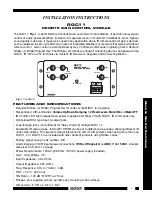
RSTi-OM User Manual
Section 3
GFK-3212A
Jun 2021
Configuring
40
The Configuration | IO-Link Settings page supports the following options.
IO-LINK Settings Page
Port Name
User-defined port or device description.
Standard ASCII characters
Max length = 80 characters
Port Mode
Default
: IO-Link
Selected IO-Link port mode. Valid settings are:
Reset - Select to disable a port or to reset/restart an IO-Link port.
IO-Link - Select to connect and operate an IO-Link device on the
port.
Digital In - Select if a DI device is attached to the port.
Digital Out - Select if a DO device is attached to the port.
Invert SIO
Default
: False
If enabled and the Port Mode is Digital In or Digital Out, this option
inverts the SIO value.
False (Disabled - Do not invert SIO)
True (Enabled - Invert SIO)
Note: This option does not affect the Auxiliary Input.
Invert Auxiliary Input
If this option is enabled, the Auxiliary bit is inverted.
Default Digital Output
Default
: Off
If the port mode is Digital Out, defines the default digital output
value that is used at startup and when there is no active PDO
controller.
Off (low voltage) - 0
On (high voltage) - 24V
Minimum Cycle Time
Default
: 4
The minimum, or fastest, cycle time at which the IO-Link device
may operate. The valid range is 4-538 ms.
You can leave the Minimum Cycle Time set to the default value and
the IO-Link Master negotiates with the IO-Link device for its
minimum cycle time. The IO-Link Diagnostics page displays the
Actual Cycle Time, which is the negotiated cycle time.
Auxiliary Input Settling
Time (0 - 10000)
The auxiliary input settling time that remains constant before that
input is considered/accepted
Auxiliary Input Hold
Time (0 - 10000)
This is how long the IO-Link Master keeps the input at its present
value. For example, if the IO-Link Master detects the input to go too
high, and the hold time is X milliseconds, then the IO-Link Master
reports the input as high for X milliseconds, even though the input
itself may have gone away already. If X is zero, then you get the
behavior currently in the field.
SIO Input Settling Time
(0 - 10000)
The SIO input settling time remains constant before that input is
considered/ accepted.
SIO Input Hold Time (0 -
10000)
This is how long the IO-Link Master keeps the input at its present
value. For example, if the IO-Link Master detects the input to go too
high, and the hold time is X milliseconds, then the IO-Link Master
reports the input as high for X milliseconds, even though the input
itself may have gone away already. If X is zero, then you get the
behavior currently in the field.
Data Storage Config
Storage Contents
Indicates that the data storage for the port is empty or displays the
Vendor ID and Product ID of the data stored on that port.
Automatic Data
Storage Upload Enable
Default
: Off
When this option is initially set to On, the IOLM saves the data
storage parameters (if the data storage is empty) from the IO-Link
device to the IOLM.
Automatic upload occurs when the Automatic Upload Enable
option is set to On and one of these conditions exists:
There is no upload data stored on the gateway and the IO-Link
device is connected to the port.
The IO-Link device has the DS upload bit on (generally because you
have changed the configuration via Teach buttons or web page).
When a port contains data storage for an IO-Link device and if you
attach a device whose Vendor and Device ID do not match, the IO-
Link LED on the IOLM flashes red to indicate a wrong device is
attached. In addition, the
IO-Link Diagnostics
page displays DS:
Wrong Sensor in the IO-Link State field.
Note: Not all device parameters are sent to data storage, this is
determined by the IO-Link device manufacturer.















































